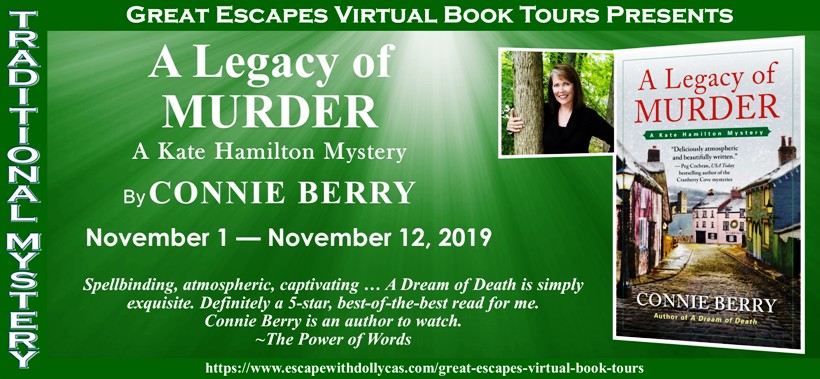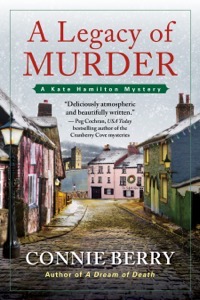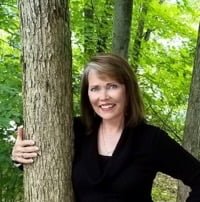

Connie Berry says she was raised by charmingly eccentric antique collectors who opened a shop, not because they wanted to sell antiques but because they needed a plausible excuse to keep buying them. Connie adores history, off-season foreign travel, cute animals, and all things British. A Legacy of Murder is the second in her Kate Hamilton Mystery series.
The Agatha Christie influence
“Like many mystery writers, I discovered Agatha Christie in my early teens—then the other authors who wrote during what has been called ‘the Golden Age of Detective Fiction.’ I was hooked. As an author, I want to pay homage to the traditional amateur-sleuth mystery—but with a modern spin. My first book, A Dream of Death, takes place on a small island, cut off from the mainland by an early winter storm. My second, A Legacy of Murder, is a version of the classic village mystery. The solutions, I hope, will be both surprising and satisfying.”
Past and present collide
Connie said that she loves traditional mysteries set in the British Isles. Her first book, A Dream of Death, takes place in the Scottish Hebrides. The second, A Legacy of Murder has the same main characters but is set in Suffolk, England. Both books deal with the influence of the past on the present. “Because my protagonist is an antiques dealer and lives with objects of the past every day, she knows that today is only the top layer of a deep and complex history that lives on, whether we perceive it or not.”
Some years ago, Connie I was researching an article for a scholarly journal. “I wanted to locate a particular farmhouse from pre-Civil War times. Unfortunately a super highway slashed through the area, obscuring all the old landmarks, and I was afraid the house had either been demolished or was hopelessly lost. As a last resort, I got off the highway and followed the geography recorded in a gazetteer published in the mid-1800s. When I crossed a creek, no more than a squiggly line on an old map, I knew I was headed in the right direction. And there was the house, still standing. It felt like time travel. The past lives on, affecting our lives for good or ill. Nowhere is that more true than in the U.K. Someone once said that history in the British Isles is never more than an inch deep. That’s the underlying thought that informs my novels.”
The value of history
Like my protagonist, Kate, I was raised in the high-end antiques trade. My house was filled with objects of the past—from the furniture in our living room to the dishes we ate on every day. I asked my mother once why we couldn’t have new furniture like everybody else. ‘Our things have a history,’ she said. ‘So much more interesting, don’t you think?’ That line made it into my first book, spoken by Kate’s mother.
“From childhood I learned to value history—and since all four of my grandparents were born in Europe, I’ve had plenty to think about and research. Several years ago I located my family farmhouse in Milltown, County Kerry, Ireland. There was the box hedge and the ivy, just as it had been in the 1880s. I knocked, showed the elderly woman who opened the door my old photograph of the house, and she invited me inside to look around. It was March, and the day was damp and cold. She and her husband lived in the huge old kitchen, in two rocking chairs around the ancient Aga cooker. Those are the kinds of experiences I cherish. We all have a past. Sometimes that past is lovely and nostalgic. Sometimes it hangs around our necks like the proverbial albatross. Either way, we can’t escape it, but how individuals and communities deal with the past provides the plot lines for my books.”

A love of foreign travel
“One of the joys of writing mysteries set in another country is going there. I’ve spent lots of time in the British Isles, first as a student at St. Clare’s College, Oxford; then as a frequent visitor. My husband and I travel to the U.K. once or twice a year. Last autumn we leased a restored fourteenth-century weaver’s cottage in the historic Suffolk village of Lavenham. While the locations I write about are fictional—the Isle of Glenroth and the village of Long Barston—they are based on real places, and I’d like to think that people who live there might recognize them.”
Connie recalled the last time she and her husband were in Scotland. They were staying in a Scots’ Baronial country house hotel in the Highlands. “I was plotting my second book at the time and got to wondering if it was possible to gain access from the house to the roof. I asked the hotel manager, and he was delighted, not only to show me the access point but also to allow me to scramble up there and get a feel for what it’s like four stories up on a slippery lead-lined roof with no parapet. And a fear of heights. That scene made it into the book—and it’s absolutely real.”
Learn more about Connie at connieberry.com.






Thank you, Terry, for allowing me to share my background in antiques and experiences in the U. K. Best of luck to you in your writing. I’ll be following your career.